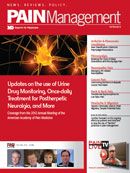American College of Rheumatology Releases Classification Criteria for Polymyalgia Rheumatica
The aching, pain, and stiffness that characterize polymyalgia rheumatica are also associated with other rheumatic conditions and illnesses frequently seen in older patients, making diagnosis difficult.
The aching, pain, and stiffness that characterize polymyalgia rheumatica are also associated with other rheumatic conditions and illnesses frequently seen in older patients, making diagnosis difficult.
The American College of Rheumatology (ACR) recently published the first classification criteria for polymyalgia rheumatica (PMR), a condition that affects nearly three-quarters of a million Americans age 50 and older. PMR is marked by the rapid onset of pain and stiffness in the neck, shoulders, lower back, and hips. The similarity between symptoms of PMR and other conditions also commonly seen in older patients can make diagnosis a challenge, as can the fact that PMR “rarely causes swollen joints or other abnormalities on physical exam,” along with the “lack of standardized tests to confirm the disease, minimal scientific research evaluating therapies, and the absence of genetic markers to identify disease risk,” according to an ACR news release that accompanied publication of the classification criteria (http://bit.ly/FQ7Zlm).
In “2012 Provisional Classification Criteria for Polymyalgia Rheumatica: A European League Against Rheumatism/American College of Rheumatology Collaborative Initiative,” published in Annals of the Rheumatic Diseases (http://bit.ly/zJiJ2X) and Arthritis & Rheumatism (http://bit.ly/AydprS), the working group of experts that created the classification criteria described the literature review and criteria selection process, and the prospective cohort study designed to evaluate the criteria.
Provisional Classification Criteria for Polymyalgia Rheumatica
Age 50 years or older Bilateral shoulder pain Abnormal C-reactive protein and/or erythrocyte sedimentation rate
Plus at least 4 points (with use of musculoskeletal ultrasound) or 5 points (no use of ultrasound) from the following:
- Morning stiffness, duration 45 minutes or longer (2 points)
- Hip pain or limited range of motion (1 point)
- Absence of rheumatoid factor and/or anticitrullinated protein antibody (2 points)
- Absence of other joint pain (1 point)
(With ultrasound) At least one shoulder with subdeltoid bursitis, and/or biceps tenosynovitis, and/or posterior or axillary glenohumeral synovitis, and at least one hip with synovitis and/or trochanteric bursitis (1 point)
(With ultrasound) Both shoulders with subdeltoid bursitis, biceps tenosynovitis or glenohumeral synovitis (1 point)
The authors of the classification criteria noted that “Uniform responsiveness to low doses of corticosteroids has been assumed to be a cardinal feature of PMR. However, there is little hard evidence to substantiate this assertion.”
Based on data from the study, the authors selected clinical criteria and developed a scoring algorithm that assigned points for each. Criteria included morning stiffness for 45 minutes or longer (two points), hip pain or limited range of motion (one point), absence of rheumatoid factor (RF) and/or anti-citrullinated protein antibody (ACPA) (two points), and the absence of other joint pain (one point). If ultrasound is used, there are two additional criteria: at least one shoulder with subdeltoid bursitis, and/ or biceps tenosynovitis, and/or posterior or axillary glenohumeral synovitis, and at least one hip with synovitis and/or trochanteric bursitis (one point); and both shoulders with subdeltoid bursitis, biceps tenosynovitis or glenohumeral synovitis (one point).
To be categorized as having PMR, patients must be age 50 years or older, experience pain in both shoulders, have abnormal C-reactive protein (CRP) and/or erythrocyte sedimentation rate (ESR), and score four points (without ultrasound) or five points (with ultrasound) on the scoring algorithm. Analysis of data revealed that a score of four or greater had “68% sensitivity and 78% specificity for discriminating all comparison subjects from PMR.” A score of five or greater had “66% sensitivity and 81% specificity for discriminating all comparison subjects from PMR.”
The authors noted that the use of ultrasound “improves the specificity of PMR diagnosis, and shows particularly good performance in differentiating PMR from non-inflammatory conditions and thus is a recommended investigation for PMR.” Although the statistical power of this study exceeds the threshold that is “conventionally considered to be useful in clinical decisionmaking," the authors “suggest that the criteria are regarded as provisional at this point awaiting validation in a separate cohort.”
An editorial accompanying the publication of the provisional classification criteria for PMR reinforces this point (http://bit.ly/FQ9dwY), emphasizing the provisional nature of the criteria and reminding readers that these are not diagnostic criteria. They “are useful for defining patient groups for clinical or epidemiologic studies,” and are not “intended to define diagnoses in clinical practice,” a point which would seem “particularly relevant in PMR, a syndrome that is common, eminently treatable, and most often initially encountered by and treated by primary care providers” who may already be achieving good results based on evaluating patients’ response to low-dose corticosteroids, and then treating appropriately.
